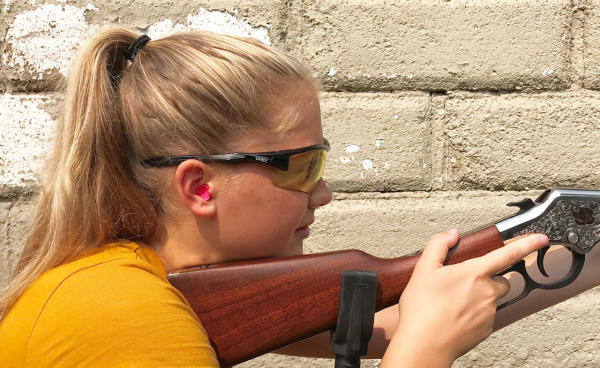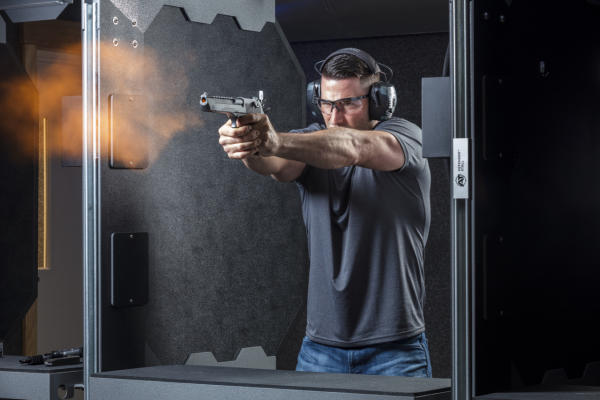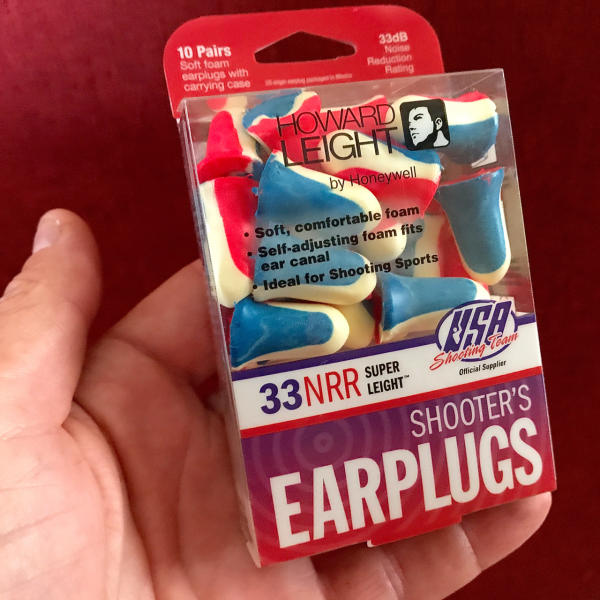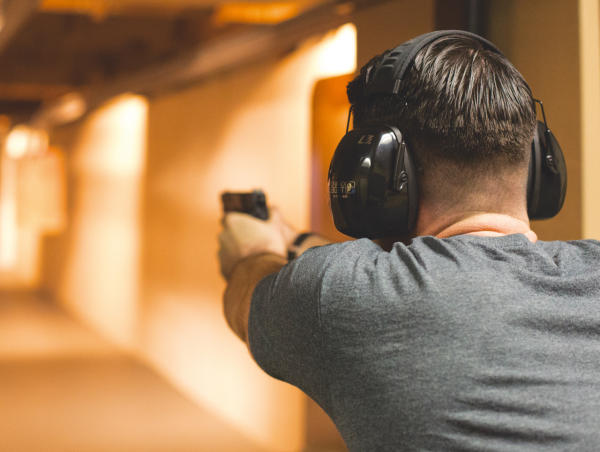




|
Today’s technologies and designs make it easy to prioritize hearing protection in your overall gun safety regimen.
It’s right there in the rules posted at any shooting range: All shooters and spectators must wear hearing and eye protection. Most shooters are equipped for compliance, quickly donning whatever earmuffs are inside their range bag. Those who come unprepared can always obtain a set of in-ear foam plugs from the range officer.
This is the extent to which most shooters think about hearing protection. They think, I have it and I’m wearing it, so my hearing is protected. But that isn’t always true.
“It’s dangerous thinking,” says Chris Leight of Howard Leight by Honeywell, a lifelong champion for the prevention of hearing loss. “Shooters have a tendency to believe that all forms of hearing protection provide adequate defense against noise-induced hearing loss, without regard to the type of firearm being used, the shooting environment, if they are using their hearing protection products properly or wearing devices that provide optimal protection. Fact is, the sound-attenuating performance of today’s diverse hearing protection options varies significantly,” says Leight, “and where and what we’re shooting makes a difference, too.”
The unfortunate truth is that most shooters simply don’t give enough thought to hearing protection. Just because our particular model or style is comfortable or convenient doesn’t mean it provides adequate defense against hearing loss in any given shooting application.
A Painless Loss
Taking a piece of shrapnel to the eye or burning one’s hand results in immediate pain and injury. When such threats exist, people are programmed to recognize them and are quick to wear safety glasses or gloves for protection.
“It’s unfortunate that people don’t think about hearing loss in the same way,” says Leight. “The threat is much more insidious, because the injury is largely painless and happens over time. They don’t realize the incremental damage being done until it’s too late.”
Ultimately, when the specialized tissues and structures in the ear—along with related brain functions—take enough abuse, they lose their functionality for the rest of a person’s life.
When is Sound Dangerous?
Sound is measured in decibels (dB). For comparison purposes, near total silence is 0dB, average conversation is approximately 60dB, a lawn mower produces about 90dB, and a jet engine at takeoff is about 150dB. The blast of a firearm can produce 130-160dB or more.
Sound levels represented in decibels increase on a logarithmic scale. That means a 10dB sound is ten times more powerful than near silence (0dB), but a 20dB sound is 100 times more powerful than near silence. Following the pattern, a 30 dB sound is 1,000 times more powerful than near silence.
The risk of hearing damage is a function of intensity (how loud) and duration (how long ears are exposed). “In the US, the Occupational Safety and Health Administration (OSHA) has established 90 dBA as the maximum exposure level for eight hours of continuous noise,” says Dr. Robert Ghent, Research Audiologist/Manager for Honeywell’s Acoustical Testing Laboratory. “OSHA also provides a 5-dB ‘exchange rate,’ which means that exposure time must be halved for every 5-dB increase in level above 90 dBA,” continues Ghent, who points out that research supports a more conservative maximum exposure level of 85 dBA for eight hours and a 3-dB exchange rate.
While continued exposure to dangerous noise can cause hearing loss within hours, impulse noises like those produced by a firearm can cause permanent damage instantly. This means every shot fired has the potential to damage the ears of the shooter or anyone nearby.
“Because of its short duration, impulse noise is thought to be safer at higher intensities, but only up to a point,” Ghent explains, “Impulse noise such as gunfire produces shock waves that affect the ear differently than continuous noise. We don’t have as good an understanding of the damage posed by impulsive noise as we do with continuous noise. Unprotected exposure to impulse noise over 137 to 140 dBpeak can cause instant hearing damage. That said, passive hearing protection generally provides protection from impulse noise in much the same way as it does continuous noise. The Noise Reduction Rating (NRR) of a hearing protector can be applied directly to both continuous and impulse noises, so a 156 dBpeak rifle report can be brought down to a safer 123 dBpeak by using properly fitted, high-attenuation hearing protection.”
The Good News
“The good news for shooting enthusiasts is that hearing loss is 100% preventable through the consistent use of appropriate and properly worn hearing protection. “Shooters can keep their ears safe with sound muffling earplugs or earmuffs,” says Ghent. “These devices have a noise-reduction rating (NRR) on their packaging shown in decibels—typically between 21dB and 30dB. The higher the number, the more protection they offer.”
Shooters can choose from several designs and styles of hearing protection. In-ear foam plugs and over-the-ear muffs are the most popular. Muffs are either passive—offering hearing protection solely by muffling or blocking sound—or electronic, which in addition to passive sound attenuation, use digital or analog circuitry to compress or “shut off” any noise above 82dB or another prescribed level.
Foam Earplugs
Foam earplugs are the most commonly used form of hearing protection for many good reasons, but primarily because they are inexpensive and provide the highest possible NRR—up to 33dB. The simple design of foam earplugs delivers great performance and protection. When inserted properly, they completely seal the ear canal, while the cellular composition of the foam creates tiny airspaces which fracture and re-fracture sound waves. But these solid performers have two common drawbacks.
“98% of people don’t put earplugs in correctly,” observes Ghent, referring to the proper practice of rolling foam plugs between the fingers to compress them before inserting them deeply into the ears. “To perform properly, they must be flush and fully expanded, deep inside the ear canal.”
The second gripe on foam plugs is that they work too well, making it difficult to hear verbal range commands or engage in conversation.
Despite these arguable drawbacks, foam earplugs—when used properly—remain the best choice for maximum protection. Howard Leight by Honeywell offers numerous models of foam earplugs designed for both men and women. Corded, uncorded, one-time use and reusable models are available, starting at just pennies per pair.
Passive Earmuffs
At the most basic level, passive earmuffs work in a manner similar to foam plugs: by forming a barrier to shield the ears from sound. Beyond that, however, today’s passive earmuffs use carefully engineered materials and designs to fracture and re-fracture sound waves, resulting in higher NRRs than were possible with earlier passive earmuff designs.
“Generally speaking, a larger earcup will produce greater sound attenuation, a higher NRR and greater protection,” says Leight, “but performance can be enhanced with other design elements. My dad (Howard Leight, the man behind the leading Honeywell brand of hearing protection products of the same name) was one of the first to start developing earmuff designs using new technologies that produced higher NRRs without increasing size or weight.”
An iteration of those Howard Leight technologies—Air Flow Control (AFC)—remains a hallmark of Honeywell Howard Leight earmuff design and performance today.
Patented Air Flow Control (AFC) delivers optimal attenuation across all frequencies without increasing earcup size or weight. “Noise blocking earmuffs traditionally attenuate very well in high frequencies, but poorly in the low frequencies, which can be the most damaging,” says Ghent. “With our patented AFC technology, we found a way to deliver superior low-frequency attenuation and more consistent performance across the whole frequency range,” Leight adds. “AFC is a big part of the science behind how we get higher attenuation on our products without adding weight or material. That’s a big deal, because many shooters prefer a slimmer, more compact earcup.”
It works like this: Inside the snap-in AFC ear cushion, a series of holes allows the cushion to breathe more effectively, channeling air out of the base cushion much like a car’s shock absorber. This controlled flow of air dampens low-frequency vibrations while maintaining excellent high frequency attenuation. AFC is a standard feature on most Howard Leight by Honeywell earmuffs.
Examples of top-performing passive earmuffs include Howard Leight’s popular Leightning Series, consisting of five distinct models offering NRRs of 22-30 and priced between $13 and $28.
Electronic Earmuffs
Electronic earmuffs combine passive sound attenuation with analog or digital circuitry to compress or “shave the peaks” off dangerous sounds above a certain level. These models employ external microphones, internal speakers and a gain adjustment, allowing the user to hear surrounding sounds at normal or even louder-than-normal levels, which is extremely helpful for conducting conversation or receiving range commands. When a dangerously loud sound over 82dB is detected, the circuitry compresses the sound to the speakers inside the earcups until the noise returns to a safe level. Because of their ability to amplify softer sounds while compressing dangerous ones, electronic earmuffs have become an attractive and popular option with shooters.
They are also growing in popularity with hunters. “Electronic earmuffs allow hunters to enhance their hearing in the field, which is helpful for detecting approaching game, while still protecting their hearing when it comes time to pull the trigger,” Leight says. “Unfortunately, too few hunters wear hearing protection in the field, because every gunshot can cause permanent damage to unprotected ears. With today’s amplifying electronic earmuffs, there are no more excuses.”
Howard Leight offers several models of electronic earmuffs that offer 4x or even 5x amplification, while effectively compressing any continuous or impulse noises 82dB or higher. The popular Impact Sport model features slim, low-profile earcups and a NRR of 22, while the Impact Pro delivers a NRR of 30. Additionally, Howard Leight’s new Impact Sport BOLT model uses digital compression circuitry to deliver a lightning-fast attack time of just .5 milliseconds, which refers to the amount of time between when the sound level goes above safe hearing levels and the instant the earmuff reacts to lower the sound to a safe level.
“At .5ms, the attack time for Impact Sport BOLT is about 250 times faster than the 1.5ms attack time of Impact Sport and Impact Pro,” advises Leight. “But there are trade-offs here, too. Impact Sport and Pro are analog, while BOLT is digital. Analog gives 350 battery hours, while Bolt yields less than half of that because the digital processor takes more power,” he explains. “Both have a 4-hour auto shutoff feature, which is handy because people often forget to turn them off. We also package and ship all Howard Leight electronics with batteries, because a lot of ranges don’t sell them. We want to make sure our customers have everything they need to protect their hearing right out of the package.”
Retail prices for Howard Leight electronic earmuff models range from $59-$150.
What’s Best for You?
Price, comfort and convenience regularly impact shooters’ hearing-protection buying decisions. Too often, however, performance—the variable that matters most—is not given adequate consideration.
“The best thing you can do—certainly with any new shooter—is give them the highest NRR (Noise Reduction Rating) available, so they are comfortable and enjoy the sport more,” says Leight. “The higher the number, the better the product protects. There is a huge difference between a NRR of 23 and a NRR of 29. Remember that sound doubles every 3dB, so a product with a 29 NRR is actually 200% better than a product with a NRR of 23.”
There are also considerations to be made based on what and where someone is shooting. For example, certain firearms produce more sound than others.
“A high-powered rifle that produces a peak of 158dB is going to be 600% louder than a .22 cal. rifle that produces 140dB,” Ghent explains. “Shooters should make hearing-protection decisions accordingly.”
The shooting environment matters, too. Indoor shooting produces a lot of reverberation, and covered outdoor shooting can be just as bad. “Sound has nowhere to go in these environments,” offers Ghent. “For louder firearms or indoor or covered shooting situations, Howard Leight’s Impact PRO electronic earmuff (NRR 30) or foam earplugs (up to NRR 33) are the smart choices.”
Doubling up—the practice of wearing both foam earplugs along with earmuffs—is a viable option as well. “Go right ahead,” Leight advises with respect to the practice. “If one isn’t working the other one will, but keep in mind that the NRR does not double. You can expect to gain 1-3dB, which amounts to a significant increase in protection.“
Do Something Today and Enjoy All Your Tomorrows
It’s quite remarkable that shooters and hunters spend so much time concerning themselves with the rules of firearms safety, while ignoring or underplaying the very real potential for injuring their ears.
Hearing protection is neither expensive, nor uncomfortable nor or inconvenient. Hearing aids, on the other hand, are, and can cost thousands of dollars. So start making hearing protection a priority in your overall shooting and gun safety regimen before it’s too late.
By Josh Lantz